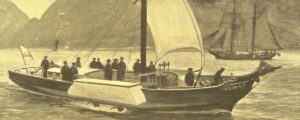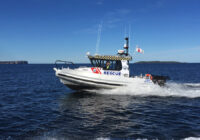The wreck of Europe’s first commercial steamship has been designated as a scheduled monument by Historic Environment Scotland. This follows the recent discovery of the wreck of Henry Bell’s Comet in the fast tidal waters of the Dorus Mor, west of Crinan, Argyll and Bute.

Created by Henry Bell, a noted 19th-century entrepreneur from Helensburgh, Comet was a wooden paddle steamer, built in Port Glasgow by John Wood & Sons in 1811-12. Designed to carry passengers between Port Glasgow and Helensburgh, the name ‘Comet’ is a direct reference to the Great Comet of 1811, a celestial event in which a comet passed by the earth and was visible to the naked eye for 260 days.
Comet was operational for eight years on the Clyde, then the Forth and from September 1819, on a new Glasgow to Fort William service. Wrecked off Craignish Point, west of Crinan, on 19 December 1820, the vessel is believed to have split in half after running aground due to a navigational error. Comet was carrying no passengers at the time of its loss, and Henry Bell and the crew managed to get safely ashore.
A dive survey by Wessex Archaeology in September 2021 confirmed that the visible remains of the wreck which survive on the seabed are likely to be from the front half of the ship. These include the engine assemblage, possible flue and paddle shaft. Further elements of the wreck are likely to survive nearby.
Historic marine protected (MPA) areas are usually the favoured designation for marine heritage sites in Scotland. However, in this instance, it has been decided to designate the wreck as a scheduled monument. This offers protection to this potentially vulnerable wreck as an interim measure until a decision is taken by the Scottish Government on designating the site as a Historic MPA.
Dara Parsons, Head of Designations at HES, said:
“In September 2020 we were invited to assess the remains of Comet for designation following its discovery by members of Dalriada Dive Club, Oban. There are very few examples of pre-1820 steamships known in the UK. As such the remains at the site of the Comet are extremely rare and merit further detailed study. Henry Bell’s Comet is of international significance as Europe’s first commercial steamship and occupies an important place in the history of steam-powered navigation.
By designating the wreck with scheduled monument status, this means that visitors can dive on the wreck but must not disturb the wreck or remove artefacts without scheduled monument consent from Historic Environment Scotland, to help protect the remains of this significant vessel.”
Tony Dalton, who coordinated the search for the wreck site, commented:
“Over three years of research, exploration and survey by a small group in Argyll established the correct facts behind the wrecking of Comet and enabled us to pinpoint the site. Together with Glasgow Museums it was very much a team effort, leading to diving and discovery by John & Joanne Beaton, together with images of the engine, two centuries after it sank.
Comet was one of the earliest steamships to be wrecked in Britain, and the initial survey by Wessex Archaeology reveals a wealth of surviving artefacts that can improve our understanding of very early steamships. We are all delighted that Comet is given the vital protection of designation so that further surveys can gain more knowledge and understanding from this wreck of national importance.”
For more information visit www.historicenvironment.scot
To keep up to date with all marine industry news visit www.marinebusinessnews.com.au







